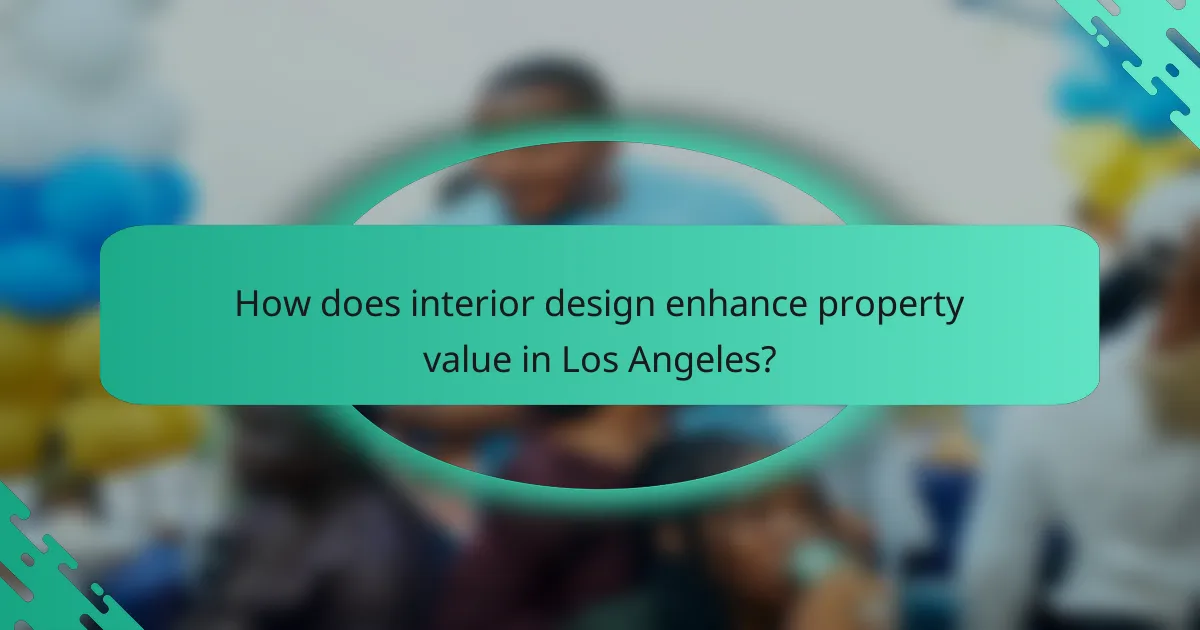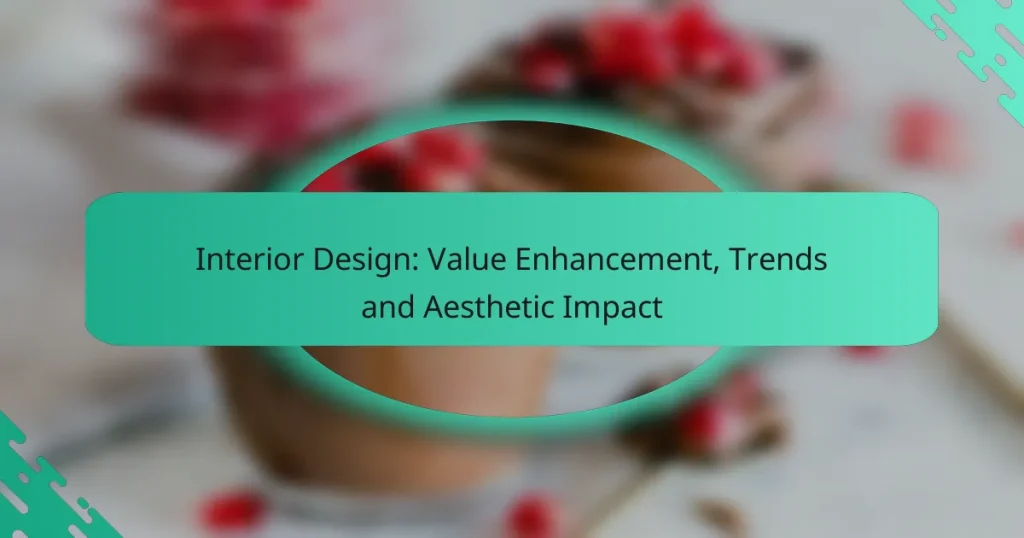Interior design plays a crucial role in enhancing property value by improving aesthetics, functionality, and market appeal. In today’s competitive real estate landscape, thoughtful design choices can attract buyers and justify higher asking prices. Current trends focus on sustainability and technology integration, creating spaces that are both visually appealing and conducive to a high quality of life.

How does interior design enhance property value in Los Angeles?
Interior design significantly enhances property value in Los Angeles by improving aesthetics, functionality, and market appeal. Thoughtful design choices can attract buyers and justify higher asking prices in a competitive real estate market.
Increased market appeal
Effective interior design creates a visually appealing environment that attracts potential buyers. In Los Angeles, where style and trends are highly valued, a well-designed space can stand out in listings and during showings.
Consider using neutral color palettes and modern finishes, which tend to resonate well with buyers. Incorporating popular design trends, such as open floor plans or eco-friendly materials, can further enhance market appeal.
Higher resale prices
Properties with professional interior design often command higher resale prices compared to those without. In Los Angeles, well-executed design can increase a home’s value by a significant percentage, sometimes in the range of 10-20% or more.
Investing in high-quality fixtures, appliances, and finishes can yield a strong return on investment. Buyers are often willing to pay a premium for homes that require less immediate renovation or updating.
Improved functionality
Interior design enhances a property’s functionality by optimizing space and improving flow. In Los Angeles, where space can be limited, effective design can make small areas feel larger and more usable.
Consider incorporating multi-functional furniture or built-in storage solutions to maximize space efficiency. This not only makes the home more livable but also appeals to buyers looking for practicality in their living environment.

What are the current interior design trends in major cities?
Current interior design trends in major cities emphasize functionality, sustainability, and technology integration. These trends reflect a shift towards creating spaces that are not only aesthetically pleasing but also enhance the quality of life for their inhabitants.
Minimalist aesthetics
Minimalist aesthetics focus on simplicity and functionality, often characterized by clean lines, neutral color palettes, and uncluttered spaces. This approach encourages the use of fewer, high-quality pieces that serve multiple purposes, making it ideal for urban living where space is often limited.
To adopt a minimalist aesthetic, consider decluttering your space and selecting furniture that combines form and function. For example, a sleek sofa bed can serve as both a seating area and a guest bed, maximizing utility without sacrificing style.
Biophilic design
Biophilic design integrates natural elements into interior spaces, promoting a connection to nature. This trend often includes the use of natural materials, indoor plants, and ample natural light, which can enhance well-being and reduce stress.
To incorporate biophilic design, consider adding large windows, green walls, or indoor gardens. Using materials like wood and stone can also create a warm, inviting atmosphere that mimics the outdoors, making your home feel more serene.
Smart home integration
Smart home integration involves incorporating technology into interior design to enhance convenience and efficiency. This trend includes smart lighting, thermostats, and security systems that can be controlled remotely, providing both comfort and peace of mind.
When integrating smart technology, focus on user-friendly devices that seamlessly fit into your design. For instance, smart speakers can double as decor while providing voice-activated assistance, and smart thermostats can optimize energy usage, potentially lowering utility bills.

How can local interior designers improve aesthetics?
Local interior designers can significantly enhance aesthetics by tailoring design solutions to individual preferences, utilizing regional materials, and providing expert color consultations. These strategies not only elevate the visual appeal of a space but also create a cohesive and inviting atmosphere.
Personalized design solutions
Personalized design solutions focus on the unique tastes and lifestyles of clients. Designers often conduct thorough consultations to understand their clients’ needs, preferences, and functional requirements. This tailored approach ensures that every element in the space resonates with the client’s personality and enhances overall aesthetics.
For instance, a designer might incorporate specific styles, such as modern minimalism or rustic charm, based on the client’s vision. This customization can range from selecting furniture and decor to optimizing layouts for better flow and functionality.
Use of local materials
Utilizing local materials not only supports the community but also adds authenticity to interior designs. Local resources often reflect the cultural heritage and natural beauty of the area, creating a unique aesthetic that resonates with residents. Examples include reclaimed wood, regional stone, or textiles produced by local artisans.
Incorporating these materials can enhance sustainability and reduce transportation costs, making projects more environmentally friendly. Designers should consider the availability and durability of local materials to ensure they meet both aesthetic and practical needs.
Expert color consultation
Expert color consultation involves selecting hues that complement the overall design while influencing mood and perception. Designers analyze factors such as lighting, room size, and existing furnishings to recommend color palettes that enhance the space’s aesthetics. Warm tones may create a cozy atmosphere, while cool colors can evoke calmness and spaciousness.
Clients can benefit from color theory insights, which help in making informed choices. A practical tip is to test paint samples in different lighting conditions before making a final decision, as colors can appear differently throughout the day.

What factors should you consider when hiring an interior designer?
When hiring an interior designer, consider their experience, client feedback, and how well their services fit your budget. These factors will help ensure you select a designer who can effectively meet your aesthetic and functional needs.
Portfolio and experience
Reviewing a designer’s portfolio is crucial to understanding their style and expertise. Look for a diverse range of completed projects that align with your vision, whether it’s modern, traditional, or eclectic.
Experience matters; designers with several years in the field are likely to have refined their skills and developed valuable industry connections. Consider asking about their specific experience with projects similar to yours.
Client testimonials
Client testimonials provide insight into a designer’s reliability and quality of work. Seek out reviews on their website or third-party platforms to gauge past clients’ satisfaction.
Don’t hesitate to ask the designer for references. Speaking directly with previous clients can give you a clearer picture of what to expect in terms of communication, professionalism, and overall project satisfaction.
Budget alignment
Establishing a clear budget is essential when hiring an interior designer. Discuss your financial parameters upfront to ensure the designer can work within your limits and avoid unexpected costs.
Many designers offer tiered pricing structures or packages. Compare these options to find a service that aligns with your budget while still meeting your design needs. Be prepared for potential additional costs for materials or specialized services.

What are the common mistakes in interior design projects?
Common mistakes in interior design projects include poor spatial planning, inadequate lighting choices, and neglecting personal style. Addressing these issues can significantly enhance the overall aesthetic and functionality of a space.
Ignoring spatial planning
Ignoring spatial planning can lead to cramped or inefficient layouts that hinder movement and usability. It’s essential to consider the flow of the space and how furniture placement affects daily activities.
To avoid this mistake, create a floor plan that outlines the dimensions and intended use of each area. Use tools like 3D modeling software or even simple graph paper to visualize the arrangement before making any purchases.
Overlooking lighting choices
Overlooking lighting choices can drastically affect the mood and functionality of a room. Proper lighting not only enhances aesthetics but also improves the usability of the space.
Incorporate a mix of ambient, task, and accent lighting to create a well-lit environment. For instance, use overhead fixtures for general illumination, table lamps for reading, and wall sconces to highlight artwork. Consider natural light sources as well, and choose window treatments that maximize daylight.
Neglecting personal style
Neglecting personal style can result in a space that feels impersonal and uninviting. Interior design should reflect the tastes and preferences of those who live in the space.
To ensure your design resonates with your personality, select colors, patterns, and furnishings that you love. Incorporate meaningful decor items, such as artwork or family heirlooms, to create a unique atmosphere. Regularly assess your space and make adjustments as your style evolves.

How do permits affect interior design in California?
Permits are crucial in California’s interior design process as they ensure compliance with local building codes and regulations. Obtaining the necessary permits can influence project timelines, costs, and design choices significantly.
Regulatory compliance
Regulatory compliance in California involves adhering to state and local building codes, zoning laws, and safety regulations. These regulations dictate various aspects of interior design, including structural changes, electrical work, plumbing, and fire safety measures.
Before starting a project, designers must determine which permits are required based on the scope of work. Common permits include building permits for structural alterations, electrical permits for wiring changes, and plumbing permits for new installations. Failing to secure the appropriate permits can lead to fines, project delays, or even the need to undo completed work.
To ensure compliance, consult local building departments early in the design process. They can provide guidance on required permits and help navigate the application process, which can vary significantly across different municipalities in California.


